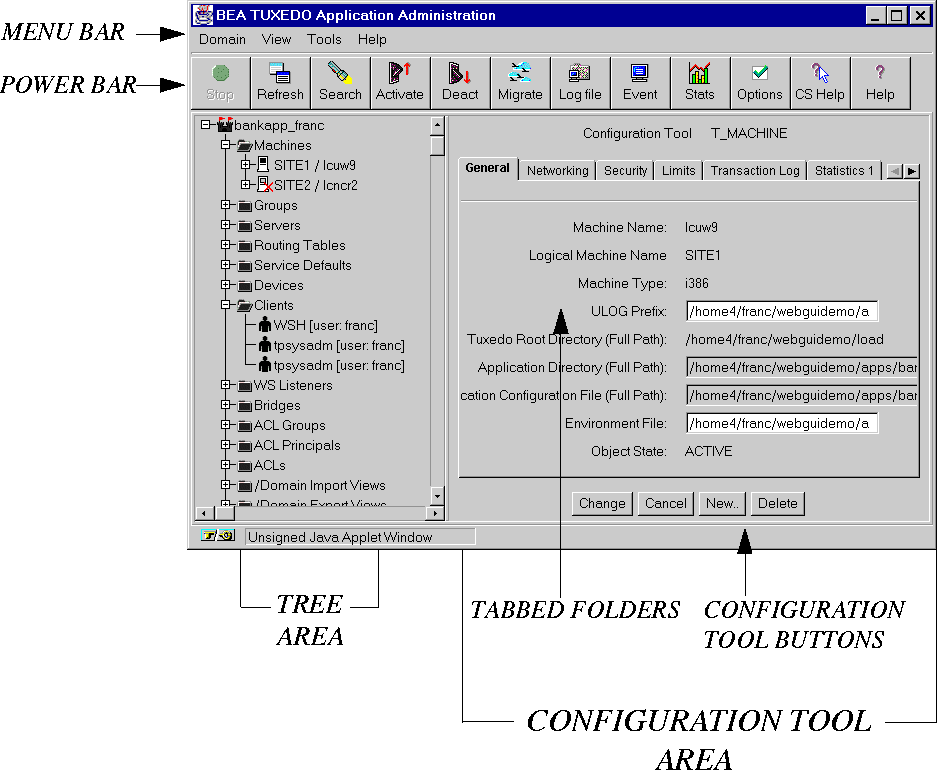
[Top]
[Previous Page] [Next Page] [Bottom]
Your BEA TUXEDO system gives you a choice of several methods for performing the same set of administrative tasks. Whether you are more comfortable using a graphical user interface or entering commands at a shell prompt, you will be able to find a comfortable method of doing your job as the administrator of a BEA TUXEDO domain.
This chapter discusses the following topics:
At the highest level, the job of an administrator can be viewed as two broadly defined tasks:
This chapter describes how these tools can be used to configure an application and how to administer a running system.
Because the BEA TUXEDO system offer great flexibility and many options to application designers and programmers, no two applications are alike. An application, for example, may be small and simple (a single client and server running on one machine) or complex enough to handle transactions among thousands of clients and servers. For this reason, for every BEA TUXEDO application being managed, an administrator must provide a file that defines and governs the components of that application.
The components:
UBBCONFIG
(ASCII) or TUXCONFIG
(binary) configuration file; a collection of programs that perform a function. A domain
represents an administrative set of functionality. These components (and others, when appropriate) are defined, or configured, in an ASCII
file that is referred to, in the BEA TUXEDO documentation, as UBBCONFIG. The UBBCONFIG file may, in fact, be
given any file name. When compiled into a binary file, the file is referred to as TUXCONFIG. During the groundwork (or
setup) phase of administration, the administrator's goal is to create a TUXCONFIG file. You have a choice of
the following three tools.
:
With your BEA TUXEDO system installed and your TUXCONFIG file loaded, you are ready
to boot your application. As soon as your application is launched, you must start
monitoring its activities and watching for problems-both actual and potential.
When problems occur, you must identify and solve them. If performance is degraded, you
may want to do load balancing or prioritize your interfaces or services. If trouble
develops on a MASTER
machine, you may want to replace it with a designated BACKUP machine.
As the processing and resource usage requirements of your application evolve, you may need to add machines, servers, clients, interfaces, services, and so on, to your existing system.
The job of run-time administration encompasses many tasks, from starting and stopping the application, to monitoring activity, troubleshooting problems, and dynamically reconfiguring the application. Again, you have a choice of three tools for performing these tasks: the Web-based GUI, the command-line interface, and the AdminAPI.
The BEA TUXEDO Web-based GUI is a graphical user interface that enables you to perform most administrative tasks for a BEA TUXEDO application. Figure 2-1 shows the Main Window that is displayed when you bring up the Web-based GUI for the first time. The four major sections of the main window are:
After you have set up and activated a domain, the Tree will be populated with labeled icons, representing the administrative class objects in your domains. In addition, as soon as you start using the Configuration Tool, the right-hand column dedicated to that tool will be populated with tabbed folders in which you enter information needed for configuration.
Figure 2-1 The Main Window of the Web-Based GUI

You can use the following commands to administer the BEA TUXEDO system. This document provides procedures for administrative tasks that are based on the command-line interface. For details about individual commands, see the BEA TUXEDO Reference Manual.
tmboot-Activates the
BEA TUXEDO application that is referenced in the specified configuration file. Depending
on the options used, the entire application or parts of the application are started. tmloadcf-Parses the
UBBCONFIG file and loads the binary TUXCONFIG configuration file. tmunloadcf-Unloads the
TUXCONFIG configuration file. tmconfig-Dynamically
updates and retrieves information about the BEA TUXEDO configuration for a running system.
dmadmin-Updates the
compiled BDMCONFIG
(binary domain configuration file) while the system is running. tmadmin-The BEA TUXEDO
Bulletin Board interpreter. This command is used primarily to produce information about
configuration parameters. Once invoked, you can enter many administrative commands that
duplicate the functions of other commands. For example, the tmadmin shutdown command is
identical to the tmshutdown
command. tmshutdown-Shuts down
a set of specified BEA TUXEDO servers, or removes a set of BEA TUXEDO services listed in a
configuration file. The AdminAPI is an application programming interface (API) for directly accessing and manipulating system settings in the BEA TUXEDO Management Information Bases (MIBs). The advantage of the AdminAPI is that it can be used to automate administrative tasks, such as monitoring log files and dynamically reconfiguring an application, thus eliminating the need for human intervention. This advantage can be crucially important in mission-critical, real-time applications.
For an example of a program written with the AdminAPI, see
Chapter 18, "Event Broker/Monitor."For details about the MIBs, see ACL_MIB(5),
APPQ_MIB(5), EVENT_MIB(5), MIB(5), TM_MIB(5), and WS_MIB(5) in the BEA TUXEDO
Reference Manual.
Note: An online version of the BEA TUXEDO Reference Manual is available on the BEA TUXEDO Online Documentation CD. From the BEA TUXEDO home page, click Reference Manual Pages-->Reference Manual: Section 5.
[Top] [Previous Page] [Next Page] [Bottom]